LC Collection is a furniture line created by Le Corbusier’s and introduced in 1928 at the Salon d‘Autumne in Paris.
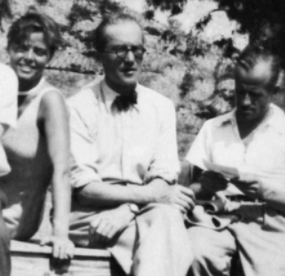
Image source: https://www.smow.de/pics/ca-002-000/desc/ca-lc2sessel-designer-ds.jpg
Le Corbusier
Despite Le Corbusier‘s focus on ready-made furniture to refurbish and accompany his project, he entrusted this role to the simple, modern pieces manufactured by Thonet . However, by 1928, this changed when he first began experimenting with interior and furniture design. Then, together with his cousin cousin, Pierre Jeannaret, and fellow architect Charlotte Perriand, he collaborated on this new approach.
By the same year, the duo put into practice the ideas Le Corbusier had first outlined in his design book, “L’Art Décoratif d’aujourd’hui” (meaning “The Decorative Art of today”). Above all, he classified and subdivided furniture pieces in three main types: type-needs, type-furniture, and human-limb ombjects.
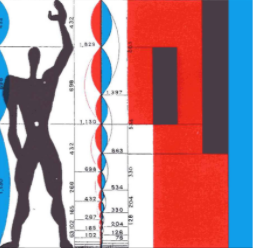
Image source:https://search.creativecommons.org/photos/aa085a08-aa78-4293-ae84-19e66a79eff8 by 準建築人手札網站 Forgemind ArchiMedia
The first products of the collaboration are the three chrome-plated, tubular steel chairs, The Maison la Roche in Paris and a pavilion commissioned by Barbara and Henry Church. The line of furniture was further expanded for Le Corbusier’s 1929 Salon d’Automne installation, “Equipment for the Home.”
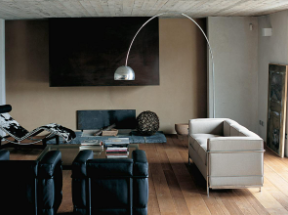
Image source: https://www.smow.com/en/manufacturers/cassina/lc-collection/lc2-armchair.html
LC Series
LC1
A direct answer to traditional furnishings, perceived by Le Corbusier as obsolete and relic-like, the sleek tubular shapes of the LC1 created a stark contrast to the suffocating wads of padding and upholstery permeating the furniture trends of the time. Designed in 1928, the chair is notable for the structure of its back, attached to the frame via a rod. Further, this design allows the recline’s tilting angle to change as the user shifts poisition and offers continuous comfort and optimal support. Complemented by a natural hide lining, offering “sensual warmth” to the cold purity of the steel tubes, this piece encapsulates the sleek “functional elegance” of Le Corbusier’s “equipment de l’habitation.”
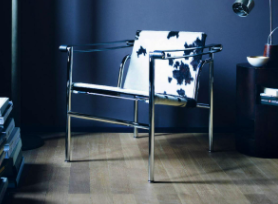
Image source: https://www.smow.com/en/manufacturers/cassina/lc-collection/lc1.html
LC2
The LC2 and LC3 Collections (1928), referred to by its creators as “cushion baskets,” are a modernist response to traditional club chairs. Its most iconic feature is the reversal of a traditional sofa structure, which put the metal supports outside the cushions. Further, they aimed to provide the same comfort of a regular padded surface, combined with the industrial, elegant aesthetic of the modernist International Style.
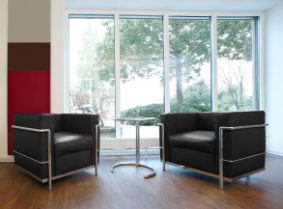
Image source: https://www.smow.com/en/manufacturers/cassina/lc-collection/lc2-armchair.html
LC4
Designed in 1928, the LC4 Chaise Longue (or “long chair” in English) was dubbed the “relaxing machine” because of how it mirrored the body’s natural curves, while appearing to float above its steely supports. The design’s main feature was the seemingly unlimited number of sitting angles poses accomodated by the LC4. Moreover, the moving frame adjusts itself to better suit the user, from an upright position to a fully reclined one. Today, the LC4 is part of the permanent collection at the Museum of Modern Art in New York.
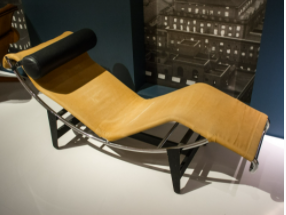
Image source:https://search.creativecommons.org/photos/718a3bce-a7ef-429c-a275-4626a8ea2a04 by Tim Evanson
LC6
The ethereal, yet bold, LC6 Table (1928) first saw the light in 1929, at the Salon d’Autumne in Paris. Here, Le Corbusier and his team’s revolutionary collection left the city – and the design world at large – stunned. Made in aeronautical steel, the base is welded for a seamless finish with sculpted angles and smooth, mitered corners. Further, the tabletop is a 0.6-inch-thick rectangle of Italian glass, making the LC6 equally feasible as a dining table or in a conference room. Together, these elements provide an unsurpassed sense of line, scale and proportion. Additionally, the end result is a mathematically refined structure of glass and steel that still acts as a high point of the International Style and 20th century design.
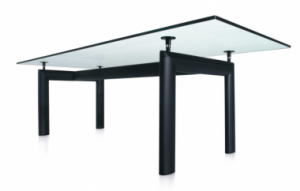
Image source: https://www.smow.com/en/manufacturers/cassina/lc-collection/lc6-table.html
LC8
The LC8 Swivel Stool (1928) is the result of a long line of experiments, beginning with an attempt to fashion a chair by wrapping inner tubes from tires around a steel frame. As each trial became more refined than the preceding one, a clear vision started taking form. Moreover, the final model, consists of a round, thickly padded seat atop a curving claw-like vase of tubular steel, conjoined by a swivel mechanism evoking a buoyant look.
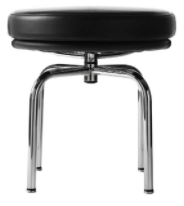
Image source: https://www.smow.com/en/manufacturers/cassina/lc-collection/lc8-swivel-stool.html
LC Collection
- LC3 – Grand confort, grand modèle referred as Cushion Baskets (1928)
- LC5 – Sofa Bed
- F – Canapé
- LC7 – The Swivel Chair(1928)
- LC9 – Bathroom Stool
- LC10 P – Rectangular Low Table
- LC11 P – Table
- LC12 – Table designed in 1925 for Villa La Roche
- LC13 – Fauteuil Wagon Fumoir
- LC14 – Tabouret (1952 – 1959) (Tabouret LC14.01, Tabouret LC14.02)
- LC15 – Table De Conférence
- LC16 – Table De Travail Avec Rayonnages
- LC17 – Portemantea (1957)
- LC19 – Table Esprit Nouveau
The Design Team
Widely considered one of the most influential architects of the 20th century, Le Corbusier is credited with revolutionizing the face of modern urban architecture and updating it to fit into the technological age. As a result, his legacy translates into a strong sense of purpose, which met the needs of a democratic society dominated by a machine.
Further, Le Corbusier combined a passion for classical Greek architecture with attraction to the modern engine, publishing his ideas in a book entitled “Vers une Architecture.” In the book, he refers to the house as a “machine for living,” or an industrial product that should include functional furniture or “equipment de l’habitation.” Additionally, the LC Collection furniture line, birthed with his cousin and close collaborator (since 1922) Pierre Jeannaret, launched a new rationalist aesthetic, that epitomized the International Style.
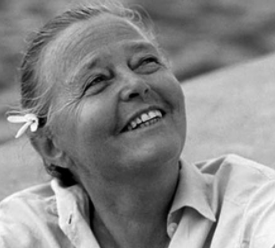
Image source: https://www.smow.com/en/manufacturers/cassina/lc-collection/lc8-swivel-stool.html
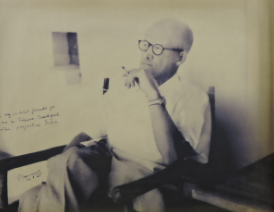
Image source:https://search.creativecommons.org/photos/45a91bd8-032c-4d0d-a46d-a83d1a1ab14d by Harvinder Chandigarh
In October 1927, the pair drew on the contribution of young architect Charlotte Perriand, who had established a strong architectural reputation during the time. Their partnership, lasted until 1937, proved to be extremely fruitful, both in terms of their achievements and their professional successes. Together with Charlotte Perriand, the pair tackled the innovative project for “l’équipement de la maison.” In addition, they, thanks to Cassina’s ongoing interest, created a golden standard for elevated concepts and high quality results.
Made in Cassina
In the 1960s, the “Cassina I Maestri” collection reissued classic, highly prized furniture of the preceding decades, compounding the original designs with an intense, in-depth analysis of their meanings.
Drawings, sketches, prototypes and every other available document, whose exclusive access was held by Cassina alone, were closely studied. Further, this subsequently helped to establish contact and cooperation with the descendants of the original designers.

Image source: https://www.smow.de/pics/ca-009-000/desc/ca-lc-produktfamilie-ds.jpg
Thanks to this, it is now possible for Cassina to revisit these products with all new editions. They can perfectly reflect the original vision while at the same time updating them with innovative technologies and materials. Additionally, the collaboration with Filippo Alison in 1972, undertook a strict methodology to fully bring out the finesses and details of each original author and associated design. Moreover, the collection is fully monitored by the Fondation Le Corbusier and the heirs of Charlotte Perriand and Pierre Jeanneret.
Info sources:
https://www.cassina.com/en/lc-collection/history/made-in-cassina
https://en.wikipedia.org/wiki/Le_Corbusier%27s_Furniture
http://www.dwr.com/living-lounge-chairs/lc1-sling-chair/5743.html?lang=en_US
http://www.dwr.com/living-lounge-chairs/lc2-petit-modele-armchair/4026.html?lang=en_US
http://www.dwr.com/living-lounge-chairs/lc4-chaise-longue/6515.html?lang=en_US
http://www.dwr.com/dining-tables/lc6-table/5014.html?lang=en_US
http://www.dwr.com/living-ottomans-benches-stools/lc8-swivel-stool/4052.html?lang=en_US
